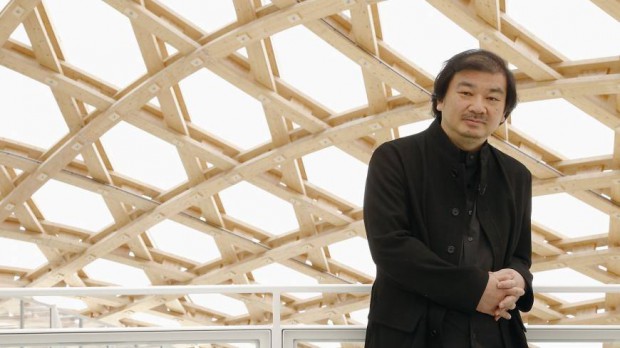
Architect Shigeru Ban at the opening of the Centre Pompidou-Metz, which he designed. Photo courtesy of The Japan Times.
Today, architect Shigeru Ban will walk away with $100,000 and a bronze medallion—maybe someone will throw in a bouquet of flowers, just for good measure. He will be honored with the Pritzker Architecture Prize, an award granted annually to a living architect for his or her contributions to society. The choice of Ban, a well-regarded architect at Kyoto University of Art and Design who’s become known for disaster-relief projects, eases at least one of the criticisms the Pritzker jury has received in recent years; that is, the award has become focused on male starchitects, to the detriment of the award’s ambitions to recognize humanitarian architecture practices, especially among women. (It wasn’t until 2004 that the organization granted an award to a woman, with the honor going to Zaha Hadid.)
This isn’t to say that Shigeru Ban only focuses on disaster-relief projects. Projects of note include museums like the Centre-Pompidou Metz and privately commissioned luxury villas Maison H and Maison S on a private island in the Caribbean. Closer to home, Shigeru Ban designed the Metal Shutter Houses, an 11-story condo building found in Chelsea, right along West 19th Street. (ArchDaily has quite a pessimistic take on how the Pritzker Prize will translate into skyrocketing prices for these condos, now that they’ll be associated with the “Pritzker” brand.)
Ban’s never been content with this status quo, however. He’s admitted, to much chagrin, that much of the contemporary architecture field—like the art world—relies on meeting the demands of the world’s wealthiest. “After I became an architect I was quite disappointed in my profession because mostly we are working for privileged people who have the power and money,” he told Voice of America earlier this year. “I’m interested in making monuments, but I thought we can use our experience and knowledge for the general public, even for the people who lost their houses through natural disasters.”
Ban’s involvement with disaster-relief architecture goes back some decades, beginning in 1994 when he traveled to Rwanda following the country’s civil war. His projects have ranged from a waterproofed church made out of paper (Takatori Paper Church, Kobe, Japan) to emergency shelters (in Haiti, Rwanda, Japan, Turkey, and India) made out of affordable, easily transportable materials like paper tubing and plastic bottles.
Now that Ban’s taking home the Pritzker Architecture Prize, what can we expect next? Ban just put the finishing touches on a temporary pavilion for the Brazilian Embassy in Tokyo, designed to celebrate the World Cup; he has a forthcoming project to build research stations and schools in the wilds of the Amazon, commissioned by the Brazilian Environment Ministry. And yes, we can probably expect some new condos, too.


Comments on this entry are closed.